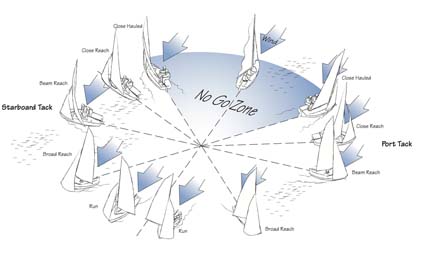Content Provided by US SAILING.
Points of Sail
Sailing needs wind and water. Wind on the sails can push – and even pull – the hull through the water. The wind direction determines how to position the sails to keep the boat moving forward. Sailors should know where the wind is coming from and the wind angle relative to their boat for sail-trim purposes.
Once you know the wind direction, you can trim the sails for the direction you want to go. In the simplest form of sailing, a boat and its sails can be pushed "downwind," with the wind coming over the stern. But keep in mind that if you sail downwind, you will need to work your way back upwind to return to your starting place.
Directions of Sail Trim
The No-Go Zone is roughly a 90° area that is too close to the wind to sail in effectively, but it is possible to sail on either side of the zone and zigzag your way to windward. For the rest of the wind circle you can match the correct sail position to the wind – sails are pulled in tighter for sailing upwind and let out farther for sailing downwind. Sailors can reach destinations in all directions.
Sailors divide the wind circle into six sections, one being the No-Go zone. The others are the five points of sail.
Upwind sailing is sailing toward the direction from which the wind is blowing. It includes two points of sail: Close-Hauled and Close Reaching.
Sailing across the wind is called Beam Reaching.
Downwind sailing refers to sailing in the direction to which the wind is blowing. It includes both Broad Reaching and Running.
The same five points of sail apply whether the wind is coming over the port or the starboard side of the boat. (click image for full-size)


